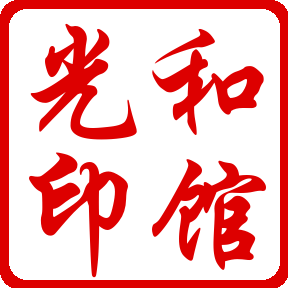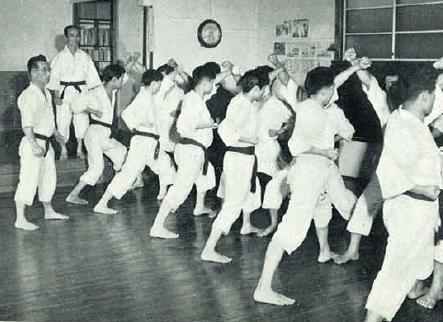Japan has culturally and historically been an ordered and hierarchical society. Therefore it comes as no surprise that its martial traditions (武道-budo) mirror this same structure. Until the conclusion of WWII, Japanese martial traditions were designated as different styles (流-ryu) or off-shoots (派-ha) and were centrally administered by the Great Japan Martial Virtues Association (大日本武徳会-Dai Nippon Butoku Kai). Therefore it must have been quite a shock when the fledgling martial tradition of Okinawa Karatedo made its way to the Japanese mainland.
Here was a tradition that was, for the most part, completely undocumented, relied on oral history, and did not adhere to the Japanese martial tradition of styles and off-shoots. Although privately many of Okinawan teachers simply referred to their tradition as ‘Ti’ (手), most eventually succumbed to the pressure of mainland Japanese culture and eventually named their respective systems. Kyoda Juhatsu named his Tou’on-ryu, Miyagi Chojun named his Goju-ryu, Mabuni Kenwa named his Shito-ryu, and so on.
There was, however, an exception, Toyama (Oyadomari) Kanken. Toyama Kanken (1888-1966) was born in Shuri, Okinawa and like many Karate teachers of his generation had graduated from the Okinawa Teacher’s College. Toyama was a student of Itarashiki Pechin, one of Matsumura Sokon’s students, as well as Itosu Anko. While in Taiwan working as a teacher, Toyama studied Chinese chuan’fa under Sho Seiko (Japanese reading). He eventually moved to Tokyo in 1935 and founded the Shudokan dojo where he began instructing students. In 1956, Toyama published a book entitled, “The Secret Techniques of Karatedo” (Okugi Hijutsu Karatedo 奥技秘術空手道) and in it he wrote an essay about Karate styles. In particular he took umbrage with Miyagi Chojun and his style Goju-ryu. It seems that for Toyama the entire notion of Karate styles was preposterous.
Below is the translated essay by Toyama for you to read and come to your own conclusions. I think you will enjoy it or at the very least it will make you think about why we have Karate styles in the first place. My own personal view is that Karate styles are simply case studies. In other words, one person’s ideas and techniques about what worked for him in a physical encounter. These were then added to by subsequent generations. Therefore, one could argue that Karate styles are a (de)illusion. My own view is that the only true link you have to Karatedo is your immediate dojo and teacher. Anything else is peripheral. Like all posts and translations in this blog, if you’d like to use them then please link to it and do not cut and paste the whole blog post.
Karate Styles by Toyama Kanken
Originally published in “The Secret Techniques of Karated0” (Okugi Hijutsu Karatedo; 奥技秘術空手道), 1956 pg. 18 – 23.
A question often asked by novices who do not understand Karate is, “Are there different styles of Karate?” If each person thoroughly examines the essence of martial arts, I think that he can clearly understand that there is no reason to have different styles of Karate. This unarmed martial art is the most outstanding form of self-defense. It allows a person to defend himself and, in times of crisis, meet and repel an attacker. Karate is a splendid martial art, and there is no reason for it to be divided into different styles or off-shoots. Even with countless variations, there is one and only one orthodox style of Karate – much the same as there is only one “style” of sumo wrestling and boxing. Indeed, all [martial arts] depend on one’s ability and spirit.
What then is a Karate “style”? I think everyone can understand the idea of styles if they think deeply on the essentials. For example, in flower arranging, how can a person present a flower more beautifully? Is it through different placements, combinations, and arrangements of flowers? The notion of beauty is individual. It depends on his education, and personal preferences. It is only natural and reasonable that we can understand the many different styles of flower arrangement once we know its ideals.
When expressing courtesy, it is customary for Japanese people to bow, while in the West, it is common to express courtesy in the form of a handshake. There are many different ways to express courtesy which have been developed from this one basic concept of ‘courtesy’. If you think about the essence of courtesy, then even what may appear to be an irrational way of showing courtesy is just one aspect of the larger “family” of courtesy.
This is the same issue present in Karate styles and has led to the creation of Shorin-ryu and Shorei-ryu as well as Shito-ryu and Goju-ryu. People nowadays say that Shaolin Temple boxing (Shorinji Kenpo) gave rise to Shorin-ryu and the Zhaolin Temple boxing (Shoreiji Kenpo) gave rise to Shorei-ryu as if this was a fact. However, there are no historical grounds to support the existence of these two “styles”.
Buddhism entered China about 1000 years ago when Bodhidharma entered Honan province and founded the Chan (Zen) Shaolin Temple. From this temple, two sutras based on strengthening the body and martial arts were passed on, the Xi Sui Jing (洗髓经-Sentaikyo) and the Yijin Jing (易筋經-Ekikinkyo). In contrast to Shorin-ryu, there is the so-called Zhaolin Temple boxing. However, there are no details of the whereabouts and history of the Zhaolin Temple. Therefore, there is no relationship between Shaolin temple boxing and Shorin-ryu or Zhaolin temple boxing and Shorei-ryu.
If we examine, analyze, and break down the essence of Shorin-ryu and Shorei-ryu, we can see that the strikes, kicks, techniques, the application of strength and pliability, etc., are the same. Even if some differences can be seen, such as the speed in advanced kata, this is simply a natural extension of [one‘s] Karate training. It is normal in Karate to have different ideas of the use of speed, strength, and pliability when training. Therefore, the idea of different styles is fundamentally wrong. We can only conclude then, that Shorin-ryu and Shorei-ryu are both one and the same.
Next, Goju-ryu and Shito-ryu are both simply Karate. Strictly speaking, Shito-ryu is contained within Goju-ryu. Shito-ryu combines the kanji of the revered teachers Itosu Anko and Higaonna Kanryo by taking the Ito (糸 also read “shi”) of Itosu and combining it with the Higa(shi) (東 also read “tou”) of Higaonna. Goju-ryu was named by taking the go (剛) of go-jutsu (剛術 – hard technique) and the ju (柔) of ju-jutsu (柔術 – pliable technique).
Regardless of the method, almost all empty hand techniques fall within the range of goho (剛法 – hard method) and juho (柔法 – pliable method). Boxing is the hard method of Karate, while Judo is the pliable method of Karate. People think that Karate is simply a hard method, but people simply do not know what Karate is. Karate as a martial art includes both go and ju. Pliability (ju) can be found in the hard method (go), and hardness (go) can be found in the pliable method (ju).
Breaking down the hard and pliable methods results in thousands of variations: For example, tsuki (punches), nuki (stabs), kiri (slashes), keri (kicks), dougyaku-gi (joint locks) are hard methods (go). While nage (throws), taosu (knockdowns), oshi (presses), shibori (twisting), tori-gi (seizing techniques) are pliable methods (ju). Therefore, Karate is not two separate methods of hardness and pliability; it is a [complete] martial art.
In conclusion, the term “Goju,” as used by Chojun Miyagi for his style, is meaningless in relation to Karate as a whole. All Karate is connected, and calling his style Goju-ryu is like making the obvious distinction between a man and a woman; they are simply both human beings. I think that everyone can understand that there are no styles or off-shoots in Karate and that Karate itself should be unified.


Leave a comment